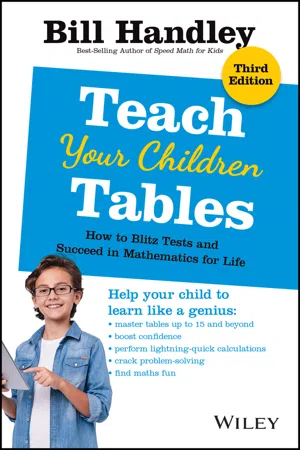
- English
- ePUB (mobile friendly)
- Available on iOS & Android
Teach Your Children Tables
About This Book
Great math skills are a head start to lasting success
Teach Your Children Tables is the ultimate guide to improving your child's mathematical abilities. Written by a renowned education expert, this book provides a proven approach to teaching that will help you enable your child to master multiplication tables in less than half an hour, and solve problems like 96 x 97 faster than they could tap it into a calculator! This updated third edition includes new chapters on factors and playing with square numbers, plus tips for learning tables up to fifteen and beyond.
Children will learn that numbers can be fun while they improve their thinking skills, boost their confidence and self-esteem, learn problem-solving strategies, and set themselves up for lasting educational success.
People who excel at maths are not necessarily more intelligent; they just use better strategies than the rest of us. This book gives you the perspective and the strategies you need to improve your child's understanding of maths, and introduce them to techniques that will help them achieve better test results, whether it's the weekly quiz, NAPLAN, or scholarship or entrance exams. Imagine helping your child:
- Perform lightning-quick calculations
- Discover easy methods of multiplication
- Learn the basic principles of mathematics
- Have fun playing with numbers
Excellent maths skills present a serious advantage, throughout school and beyond. Children who are good at maths get better grades, higher test scores, and are accepted into better schools. Maths-minded adults are more in demand professionally, in fields that pay better and provide more room for upward mobility. If you could give your child this kind of gift, why wouldn't you? Now you can— Teach Your Children Tables shows you how, and makes it feel like fun.
Frequently asked questions
Information
Part I
Learning the method
Chapter 1
Teach your child tables
Table of contents
- Cover
- Title Page
- Copyright
- Series
- Preface
- Acknowledgements
- Introduction
- Part I: Learning the method
- Part II: Having fun with numbers
- Part III: Solutions and practice sheets
- Conclusion
- Advert
- End User License Agreement